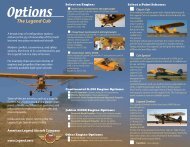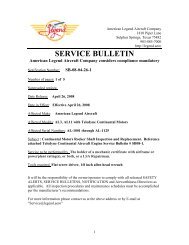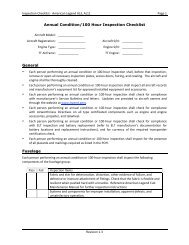Lycoming Flyer - Aircrafts sales, engines repair, spare parts
Lycoming Flyer - Aircrafts sales, engines repair, spare parts
Lycoming Flyer - Aircrafts sales, engines repair, spare parts
- No tags were found...
You also want an ePaper? Increase the reach of your titles
YUMPU automatically turns print PDFs into web optimized ePapers that Google loves.
used, either or both instruments are useful indicators. Whenthe airplane uses a constant speed propeller, the airspeedindicator is useful. Regardless of the propeller type, setthe controls for the desired cruise power as shown in thePilot’s Operating Handbook. Gradually lean the mixture fromfull rich until either the tachometer or the airspeed indicatorare reading peaks. At peak indication the engine is operatingin the maximum power range.b. For Cruise Power: Where best economy operation is allowedby the manufacturer, the mixture is first leaned from full richto maximum power, then leaning is slowly continued untilengine operation becomes rough or until engine power israpidly diminishing as noted by an undesirable decrease inairspeed. When either condition occurs, enrich the mixturesufficiently to obtain an evenly firing engine or to regainmost of the lost airspeed or engine RPM. Some slight enginepower and airspeed must be sacrificed to gain a best economymixture setting.c. Exhaust Gas Temperature Method (EGT): Refer to thearticle on this subject in the Operations section of this book.Recommended fuel management — manual leaning will not onlyresult in less engine deposits and reduced maintenance cost, butwill provide more economical operation and fuel savings.B. ENGINE GROUND OPERATIONThe engine ground operation greatly influences formation oflead salt deposits on spark plugs and exhaust valve stems. Properoperation of the engine on the ground (warm-up, landing, taxiand engine shut-down) can greatly reduce the deposition rate anddeposit formation which cause spark plug fouling and exhaustvalve sticking.1. Proper adjustment of the idle speed (600 to 650 RPM) fuelmixture, and maintenance of the induction air system will ensuresmooth engine operation and eliminate excessively rich fuel/airmixtures at idle speeds. This will minimize the separation of thenonvolatile components of the high-leaded aviation fuels greatlyretarding the deposition rate.2. The engine should be operated at engine speeds between1000 and 1200 RPM after starting and during the initial warmupperiod. Avoid prolonged closed-throttle idle engine speedoperation (when possible). At engine speeds from 1000 to 1200RPM, the spark plug core temperatures are hot enough to activatethe lead scavenging agents contained in the fuel which retardsthe formation of the lead salt deposits on the spark plugs andexhaust valve stems. Avoid rapid engine speed changes after startup,and use only the power settings required to taxi.3. Rapid engine cooldown from low-power altitude changes, lowpowerlanding approach and/or engine shut-down too soon afterlanding or ground runs should be avoided.4. Prior to the engine shut-down, the engine speed should bemaintained between 1000 and 1200 RPM until the operatingtemperatures have stabilized. At this time, the engine speedshould be increased to approximately 1800 RPM for 15 to 20seconds, then reduced to 1000 to 1200 RPM and shut downimmediately using the mixture control.C. LUBRICATION RECOMMENDATIONSMany of the engine deposits formed by combustion, regardless ofthe lead content of fuel used, are in suspension within the engineoil and are not removed by a full-flow filter. When sufficientamounts of these contaminants in the oil reach high temperatureareas of the engine, they can be baked out, resulting in possiblemalfunctions such as in exhaust valve guides, causing stickingvalves. The recommended periods of 50-hour interval oil changeand filter replacement for all <strong>engines</strong> using full-flow filtrationsystem and 25-hour intervals for oil change and screen cleaningfor pressure screen systems must be followed. If valve sticking isnoted, all guides should be reamed using the procedures statedin latest editions of Service Instruction No. 1116 and/or ServiceInstruction No. 1425, and the time between oil and filter changesshould be reduced.D. SPARK PLUGSThe fuel management techniques outlined previously will aidin minimizing spark plug fouling. Engine operation, spark plugselection and spark plug maintenance are all factors that help tokeep <strong>engines</strong> operating smoothly with leaded fuels.If the magneto check before or after flight reveals any roughnesscaused by a fouled spark plug, open the throttle slowly andsmoothly to cruise RPM, and lean the mixture as far as possible(yet with a smooth engine). After several seconds leaned, returnto the proper mixture position for takeoff and recheck the magneto.If two such attempts do not clear the fouled plug, then returnto the line and report the problem to maintenance.Spark plugs should be rotated from top to bottom on a 50-hourbasis, and serviced on a 100-hour basis. If excessive spark pluglead fouling occurs, the selection of a hotter plug from theapproved list in Service Instruction No. 1042 may be necessary.However, depending on the type of lead deposit formed, a colderplug from the approved list may better resolve the problem.Depending on the lead content of the fuel and the type of operation,more frequent cleaning of the spark plugs may be necessary.Where the majority of operation is at low power, such aspatrol, a hotter plug would be advantageous. If the majority ofoperation is at high cruise power, a colder plug is recommended.Spark plug fouling is not limited to <strong>engines</strong> that were certifiedfor 80-octane aviation fuel, but which are using the higher leaded100-octane gasoline. Therefore, the techniques recommendedherein for operation and maintenance apply to all <strong>Lycoming</strong>piston <strong>engines</strong>, but with emphasis on the 80-octane engineusing 100-octane fuel.E. SUMMARYWhen Grade 80 aviation gasoline was first phased out, thehighly leaded Grade 100 green fuel was the only alternativefor some operators. During that period of time, in the middle1970s, exhaust valve erosion was a concern for the operators oflow-compression <strong>engines</strong>. There are two reasons why this shouldnot cause concern today. First, Grade 100LL does not cause thisproblem, and second, the materials used in <strong>Lycoming</strong> exhaustvalves are highly resistant to erosion.1 6 L y c o m i n g F l y e r









